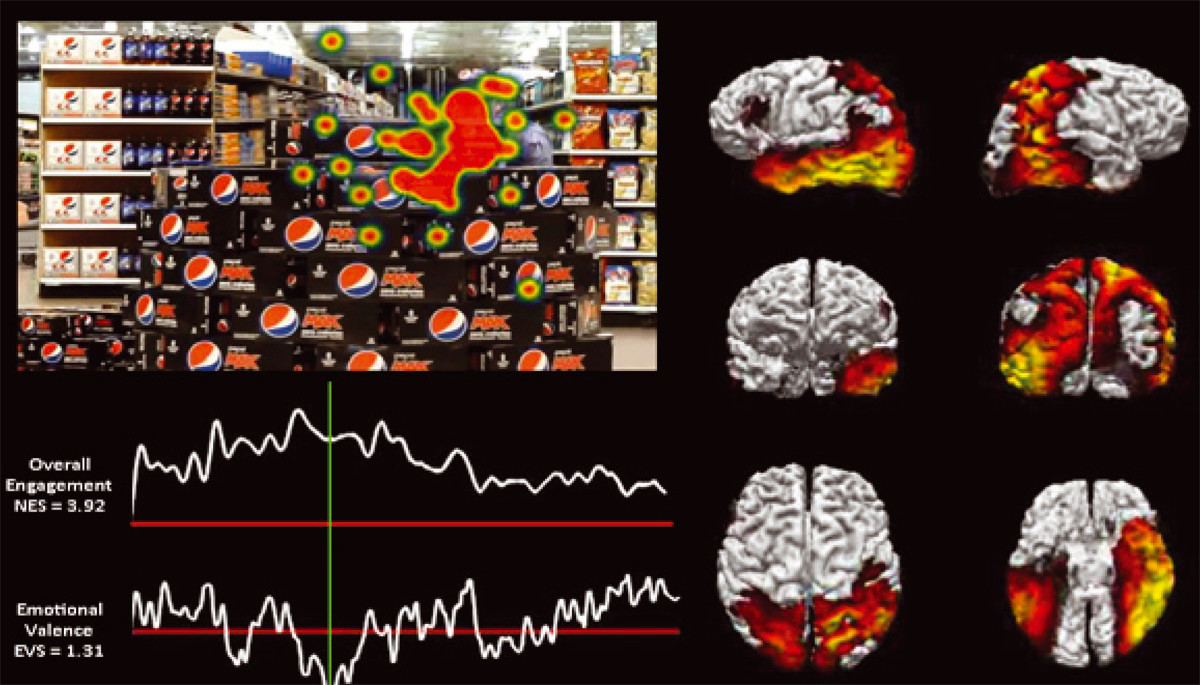In-store Neuro Research
As retailers continue to face tough competition from online merchants, they are making stronger efforts to improve the shopper experience. This includes learning how people shop when in a bricks-and-mortar retail environment and what spurs them to make a buying decision.
To gain critical insights into the shopper experience, Point of Purchase Advertising International (POPAI) conducted a Shopper Engagement Study with 13 leading supermarket retailers (including Safeway, Stop and Shop, Vons and Winn Dixie) across 17 metropolitan markets within the continental United States. The research team, which consisted of Sands Research (neuromarketing), Smart Revenue (quantitative ethnography) and Shopper Sense (overall project management) used the latest EEG and eye-tracking technologies, combined with attitudinal findings and interviews, to measure the emotional, cognitive and physiological reactions to marketing stimuli while shoppers were freely roaming in the store on their normal trip to purchase groceries. The aim of the study was to gain a better understanding of how consumers make purchasing decisions and how external factors – such as in-store displays, product packaging and shelf design – can impact those decisions.
Approach
This research study was undertaken due to the rapidly changing retail landscape, where multi-layered selling strategies, social media and shopper technology come together in-store. In this setting, where it’s been proven for a number of years that more shoppers are making in-store decisions related to their purchases, having greater knowledge of how these decisions are reached will prove extremely valuable to retailers and marketers.
In the POPAI Shopper Engagement Study, a balanced sample of more than 2,400 shopper interviews, purchase receipts with more than 33,000 items total, EEG and eye-tracking movement data from 210 individual shopping trips and an extensive audit of almost 6,000 unit displays, resulted in the largest, most authoritative study of in-store purchase dynamics ever undertaken. The study looked at five distinct measures of category performance that, when combined, give a clear indicator to retailers about the shopper marketing opportunity.

The five measures were:
- Ease of Shopping Score (ESS) indicates overall “shopability,” so a high ESS score indicates that products are organized such that shoppers can easily assess the variety of options available to them and select items they need without difficulty.
- Inspires Exploration Score (IES) indicates how well a category’s presentation encourages shoppers to spend time examining options on the shelf.
- Category Conversion, or walk-away rates, show how many shoppers failed to purchase at least one category of item they had planned to buy prior to entering the store.
- In-store Decision Rates is defined as the sum of three purchase decision types identified by comparing reported pre-store planned items and post-shopping register receipts.
- Evoked Response (EEG) and Fixation Rates (eyetracking) indicates the extent of non- conscious response when shoppers examine products in the aisle and on the shelf.
Results
After looking through more than five terabytes of data that were collected during the study, the results confirmed a previously identified trend that more shoppers are making in-store decisions related to purchases, with just over three-fourths (76 percent) of shoppers making their decisions on what to buy while in the retail environment. This was confirmed with the eye-tracking data, which showed that more than 80 percent of eye fixations (more than 200 milliseconds spent looking at an item) were on items that were not purchased. The Sands Research team also found out that a shopper’s brain produces a large positive emotional response the first time an item to be purchased is seen. After that initial view, eye fixations on the purchased item diminish rapidly. This shows that the first impression becomes a predictor of purchase and helps give valuable information to consider in package design. Specifically, product designers should keep in mind that shoppers may be viewing items from a longer distance and not right up next to a shelf. This also shows that a radical package design change will disrupt the shopping selection process of a loyal customer and make them more susceptible to alternative options.

Conclusions
This nationwide study offered the first opportunity for marketers to see exactly the shopper’s viewpoint via binocular eye-tracking data that was time synced exactly with their non-conscious brain response. (Today we can now view this streaming data in real-time.) Insights gleaned through combining neuroscience data with attitudinal information significantly improve understanding the shopper experience, the retail environment and most importantly, the opportunity for brands and retailers to put in place more effective in-store marketing strategies.
This was an important milestone for neuromarketing where the participant is not tied to the laboratory but results are collected, analyzed, reviewed and actionable insights delivered in the real world environment. Allowing a participant to freely roam while recording EEG and eye-tracking was a challenge when Sands Research tackled the POPAI contract, but has now become a standard service which is undertaken on behalf of our clients around the world.
Contact Information:
Sands Research Inc.
www.sandsresearch.com